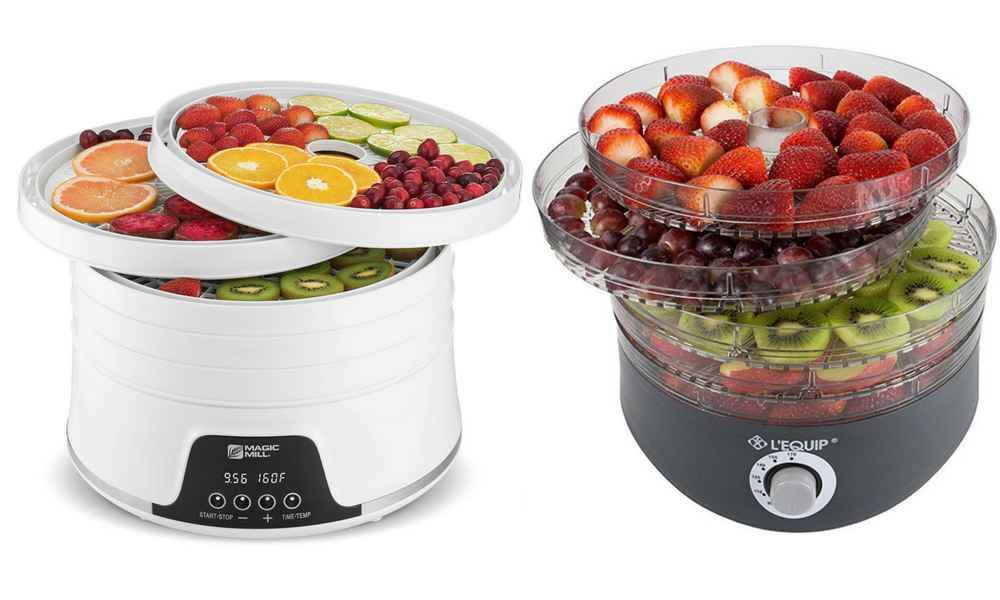Vertical Flow Dehydrators: Buying Guide
When it comes to electric food dehydrators, all of them operate on the same principle: dispersing hot air throughout the unit and, in doing so, effectively removing moisture from the foods placed on the tray. However, the direction of the air flow varies from one model of the unit to the other. It can be horizontal or vertical.
Vertical flow dehydrators are the more widespread type, and, in most cases, they are round and made out of high-quality BPA-free plastic. As the name suggests, the hot air circulates from top to bottom or from the bottom to the top, depending on the position of the heating fan. For instance, Nesco FD-75A is one of the more popular vertical flow dehydrators with a top mounted fan, whereas the impressive Presto 06301 Dehydro Digital features a bottom mounted one.
We look further into the benefits and downsides of vertical flow dehydrators to help you make a decision whether they’re the right match for your kitchen. So, keep reading, because we’ve covered everything you need to know before heading to checkout.
Pros and Cons of Vertical Flow Dehydrators
Depending on your needs and preferences, you might find that vertical flow dehydrators are more suited for you than the horizontal type. Here are the main advantages and disadvantages of circular food dehydrators that you need to know about.
Pros
- These food dehydrators are very affordable. Many of them actually cost under $100 and yet boast an impressive performance for home use—sufficient for a small family. If you’re on a tight budget, then undoubtedly these are the models for you. There is whole variety of different vertical flow dehydrators in the market, so you can actually pick and choose based on what you’ll be using it for and what your other needs may be.
- Vertical food dehydrators are usually more compact and take up less space on the kitchen countertop than their horizontal counterparts. If you have a small kitchen, you’ll particularly appreciate this. Plus, no one likes to pull heavy kitchen appliances out of cabinets—something you’ll likely end up doing if you opt for a horizontal flow dehydrator without first making space on the kitchen countertop. There’s also the fact that many vertical flow dehydrators get compressed when not in use, making them easy to take with you wherever you’re going.
- Due to the vertical airflow, these dehydrators are much more suitable for dehydrating finer foods, such as herbs and fruits.
Cons
- If you are looking for a truly powerful performance, you might find vertical dehydrators lacking. While some of these models surely pack a punch, they do not have the level of performance as horizontal flow dehydrators that have much more commercial use.
- Their capacity is not as big as that of horizontal dehydrators. Of course, most vertical flow dehydrators are expandable, but even then the capacity doesn’t compare to the shelf-style commercial appliances. There’s also the fact that these dehydrators are round and arranging food on them is harder than it is on rectangular or square shelf trays.
- Vertical air flow is not as suitable for drying thicker foods, such as meats. While they can be used to make beef jerky and similar delicacies, the process will take more time and might require tray rotation to ensure even dehydration.
- In comparison to the horizontal flow dehydrators that have a heating element and fan in the rear, these stacked tray dehydrators are more prone to cross-contamination of smells. While this isn’t true for all models, you will want to think about this before making a purchase.
What to Look for in Vertical Flow Dehydrators
If you decided that getting a vertical flow dehydrator is the best choice for you and that these compact appliances are the right fit for your dehydrating needs, there are a few more things you need to pay attention to before making the purchase.
Capacity
Vertical flow dehydrators come in different sizes and that mostly refers to the number of trays the unit includes. The basic models offer 4 to 6 trays and for most families this will be more than enough. However, for people looking to dehydrate big batches of food at one go, or for large families, a bigger number of dehydrating trays will be needed. Thankfully, most vertical flow dehydrators can be upgraded with additional trays and can be stacked for up to 20 trays per unit.
Accessories and Add-ons
What will you be using your food dehydrator for? For some people, just your basic dehydrator with an on and off switch and plain trays will cover all their needs. Others might benefit from investing in a unit that comes with fine mesh trays and fruit leather trays in addition to the basic set. Not to worry, these are all available in the market. You simply have to look!
Price
As we’ve already mentioned, vertical flow dehydrators are the more budget-friendly option. Nevertheless, a $40 dehydrator will be different from a $150 one, so make sure to set a budget that will get you the functions you need but won’t lighten your wallet too much.
Conclusion
When it comes to food dehydrators, there are so many options on the market that it can get confusing. But if you’re novice, someone on a budget, or simply someone with limited needs from a food dehydrator, a vertical flow food dehydrator is a great option. These stackable dehydrators are no-fuss, easy to use, and boast strong performance (albeit not as much as their horizontal counterparts, but nothing that a home user would complain about). They’re also perfect for small families, allowing you enough space to experiment and explore the gadget’s versatility.

